
by Rick O'Connor | Apr 8, 2021
EDRR Invasive Species
Beach Vitex (Vitex rotundfolia)
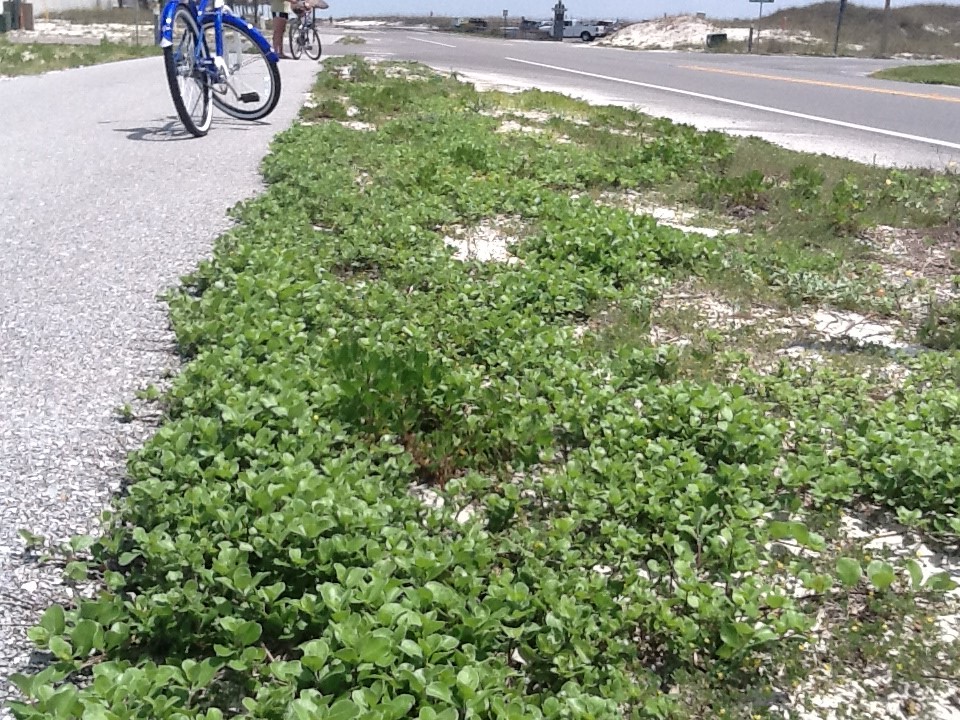
Vitex beginning to take over bike path on Pensacola Beach. Photo credit: Rick O’Connor
Define Invasive Species: must have ALL of the following –
- Is non-native to the area, in our case northwest Florida
- Introduced by humans, whether intentional or accidental
- Causing either an environmental or economic problem, possibly both
Define EDRR Species: Early Detection Rapid Response. These are species that are either –
- Not currently in the area, in our case the Six Rivers CISMA, but a potential threat
- In the area but in small numbers and could be eradicated
Native Range:
Beach vitex is native to the coastal shores of Asian countries bordering the Pacific rim. It is also found in Hawaii.
Introduction:
There are conflicting records as to when it was first introduced to the U.S. One record has it in the country as early as the 1950s. However, there are no records of plants from that stock still existing. Most records suggest the release of the plant occurred in the 1980s when it was brought to North Carolina as a potential ornamental plant. It was then used in dune restoration after a series of hurricanes and became a problem. Thus, it was intentionally introduced.
EDDMapS currently list 649 records of beach vitex. Most are in North Carolina. There are 82 records in Florida and 46 (56%) are in the Pensacola Bay area. We currently have 75 records from the Pensacola Bay area. Not all are reported on EDDMapS due to private property restrictions. Records do occur in coastal Alabama, Mississippi, as well as Okaloosa and Franklin counties in the Florida panhandle.
Distribution is most likely due to the high tolerance of salt water by the seeds and dispersal by currents, as well as intentional plantings by local landscapers and homeowners. Vitex rotundifolia is now a noxious weed in Florida and can no longer be sold.
Within our CISMA there are records in all coastal counties (Baldwin, Escambia, Santa Rosa, and Okaloosa)
Description:
Beach vitex is a perennial plant that initiates from a main taproot and extends herbaceous vines across the surface of the substrate in almost a 360° pattern. The vines can grow as much as 20 feet in length and become more woody with age. As the plant grows, secondary roots extend from each of the nodes from the above ground stems (vines) and becomes more of a shrub, reaching a height of about two feet.
The two-inch leaves are ovate in shape, a light green to blue-green color, and are aligned opposite of each other. They turn a reddish brown during the fall and winter and many plants will lose their leaves completely during this time.
The blossom is a lavender color and made of numerous small petals. The blossoms are present during the spring and summer. They will produce numerous charcoal gray fruits in fall and winter. Each fruit can hold up to four seeds. It has been reported that the plant can produce over 1000 seeds / m2.
Issues and Impacts:
After planting for dune restoration in North Carolina, the plant quickly became a monoculture. It is allelopathic creating a hydrophobic situation in the soil. This situation can cause the decline of native plants, such as sea oats (Uniola paniculata). As the plant becomes more of a shrub it decreases the amount of sunlight reaching the surface further decreasing the smaller native plants and the ability for many to germinate.
This altering of the native dune plant community can have potential impacts on the native faunal communities. There are concerns on its impacts to protected species such as beach mice and nesting sea turtles.
Having a taproot system rather than a fibrous one like the sea oat, can comprise dune integrity during tropical storms. It is known that these dune systems provide protection for natural and developed areas behind them.
Management:
Finding the plants early and removing by hand is the first and best option. The plant is relatively new to the panhandle area and smaller ones are often found. Once the small plants are found, you can simply cut the above ground vine into 2 foot sections and place in a trash bag – you should double bag this. Woody vines may puncture the bag so shorter sections may be needed for those.
Once you reach the taproot you may be able to pull it from the ground, or you may need to dig it out. This method works well in loose dry sandy soils, it may require more digging and cutting if soils are more compacted. If you cannot remove the entire taproot, we recommend spot spraying the remainder with glyphosate. Be careful not to over spray, glyphosate is non-selective and will kill any native plants it comes into contact with.
In cases where the patch of vitex is too large to remove by hand then chemical treatment will be needed. Several studies have been published as to which herbicides are effective. Imazapyr, Triclopyr, and Glyphosate are all products that have been used both in foliage application and cut stem with success. The exact concentrations vary with abundance of plants and surrounding habitats and re-treatments over a few years may be required. We recommend you reach out to your local CISMA or county extension office for more direct help on your situation.
For more information on this EDRR species, contact your local extension office.
References
Invasive Species – Beach Vitex. Rick O’Connor. 2017. UF IFAS Escambia County Blog. http://blogs.ifas.ufl.edu/escambiaco/2017/03/20/invasive-species-beach-vitex/.
Early Detection and Distribution Mapping System (EDDMapS)
https://www.eddmaps.org/
Six Rivers CISMA
https://www.floridainvasives.org/sixrivers/

by Laura Tiu | Mar 26, 2021
I am a curious person by nature. When I first moved to the Emerald Coast, I had many questions about the area. For example, why do they call this the Emerald Coast? To help answer my questions, I turned to the Destin History and Fishing Museum in Destin, FL. If you haven’t yet visited the museum, I highly recommend it for locals and visitors alike.
It was easy to see why they call this the Emerald Coast once one lays eyes on the beautiful emerald color water. Other questions weren’t so easily explained. For example, I wanted to know why the pass out of Destin Harbor is called the East Pass, when it is clearly on the west side of Choctawhatchee Bay? In fact, in the early 1900’s, the only outlet from the Bay to the Gulf was about 1.5 miles east of where the current pass resides and was called Old Pass Channel. In 1929, a storm sealed off Old Pass Channel and a heavy dose of spring rain raised Choctawhatchee Bay five feet. The threat of flooding inspired four local fishermen to take matters into their own hands and they dug a small trench across Santa Rosa Island to let the water out of the Bay. By the next morning, the trench had significantly widened into the East Pass we have today, connecting Choctawhatchee Bay to the Gulf of Mexico.

However, that still didn’t explain the East Pass moniker. To explain, we need to look west. Choctawhatchee Bay is connected to Pensacola Bay by the Santa Rosa Sound. This narrow passageway is the space between the Santa Rosa Island, a barrier island, and the mainland. In the early 1900’s, many of the goods and services traded between inhabitants in Okaloosa and Walton counties traveled on ships from Choctawhatchee Bay, through the Santa Rosa Sound, and over to Pensacola Bay, instead of going out into the Gulf. The opening between the Sound and Pensacola Bay is the West Pass, and hence the opening between the Sound and Choctawhatchee Bay is the East Pass. Another mystery solved.
If you are interested in knowing more about the history of this area, the Destin History and Fishing Museum is the place to go.

Citation: Morang, A. . A study of geological and hydraulic processes at East Pass, Destin, FL. Accessed: https://apps.dtic.mil/dtic/tr/fulltext/u2/a253890.pdf
“Foundation for a Gator Nation”

by Rick O'Connor | Dec 3, 2020
Along the northern Gulf coast is a string of long-thin sand bar islands we call barrier islands. They are called this because they serve as a barrier to the mainland from open water storms. These long sandy islands are very dynamic and constantly shift and move with the tides, currents, and waves. They can shift as far as 300 feet after a strong hurricane.

The white quartz sand beaches of the barrier island in the northern Gulf of Mexico.
Photo: Molly O’Connor
Life on these islands can be very tough. In addition to the constantly moving sand, there is salt spray in the wind, intense sunlight much of the year, high winds at times, and little rainfall to provide freshwater. Even though our area can receive as much as 60 inches of rain a year, much of this falls in the northern end of the counties, and not on the beaches. That said, there are freshwater ponds on some the islands and even larger dune lakes in Walton County – there life is not as hard.
As you cross a barrier island from the Gulf to the bay, you will cross distinct environmental zones. These zones are defined by the abiotic factors wind and salt spray and are named by their dominant plant forms having distinct animal life associated with them.

The beach zone seems life-less but it is not. Look beneath the sand.
Photo: Molly O’Connor
The beach is barren. This is the section of sand that extends from the water line of the Gulf to the first line of dunes. Few, if any plants can grow here. The high wave energy will not allow plants to grow along the shoreline, nor in the water itself. The wind and salt spray are high and the sand ever changing. All of the animal life here lives beneath the sand. They emerge when the wind and waves have slowed and scavenge on what they can find for food. Their primary production comes from the decomposition of the strands of seagrass and seaweed that line the shore – what we call wrack. Many will filter phytoplankton from the water as the waves wash in and seabirds are constant predators. When conditions get a little too much, they migrate a little offshore in deeper water to wait it out. But here fish and larger invertebrates become predators – so, they may not stay long.

The primary dune is dominated by salt tolerant grasses like this sea oat.
Inland of the beach is the first dune line – the primary dune. This dune field is dominated by grasses because woody plants cannot tolerate the high wind. Most of these herbaceous plants have fibrous root systems that trap blowing sand and form dunes. The dominant grasses found here would include panic grass, beach elder, and the sea oat. The seeds of these plants provide food for creatures like the beach mice and some birds. Ghost crab burrows are often found here seeking shelter from the high energy environment of the beach. And, as you would expect, predators visit. Snakes, coyotes, and fox seeking the small mice.

Small round shrubs and brown grasses within the swales are characteristic of the secondary dune field.
Photo: Rick O’Connor
This primary dune line blocks some of the wind and salt spray from the Gulf and allows small woody shrubs to grow. These shrubs will form a secondary dune system, which may grow slightly higher than the primary dunes. Shrubs like seaside rosemary, goldenrod, and false rosemary can be found here and give the dunes color when they are in bloom. The grasses found in the primary dune can also be found here. Beach mice and ghost crabs can work their way to this environment but because the wind is blocked by the primary dune other animals can be found here including: armadillos, opossum, a variety of snakes, and maybe even a gopher tortoise. Within the secondary dune field there are low areas that, at times, fill with rainwater. These are called swales and have their own unique wildlife. Grasses like broomsedge, needlerush, and bull rush can be found here. Along the edge you may find carnivorous plants such as the sundew. Freshwater attracts all wildlife, but the tenants could include a variety of amphibians, reptiles, and even some hardy species of fish.

The top of a pine tree within a tertiary dune.
Photo: Molly O’Connor
On the back side of the island are some of the largest dunes. These are held in place by salt tolerant trees such as live oak, pine, and even magnolia. However, these trees look different than the ones that grow in our yards. They are the same species, but their growth seems stunted and often they look like the wind has blown their growth northward. This is known as wind sculpting and all of it is caused by the salt spray coming from the Gulf. These trees form a maritime forest where a variety of wildlife species do well. Deer, armadillo, opossum, skunks, coyote, fox, raccoon, hawks, owls, eagles, all sorts of snakes and woodland birds can be found here. In these xeric conditions, it is not uncommon to find a lot of cactus. Most of these creatures are hiding during the day, but at sunset they begin to move.
During these colder winter months, we encourage you to explore these beach habitats.
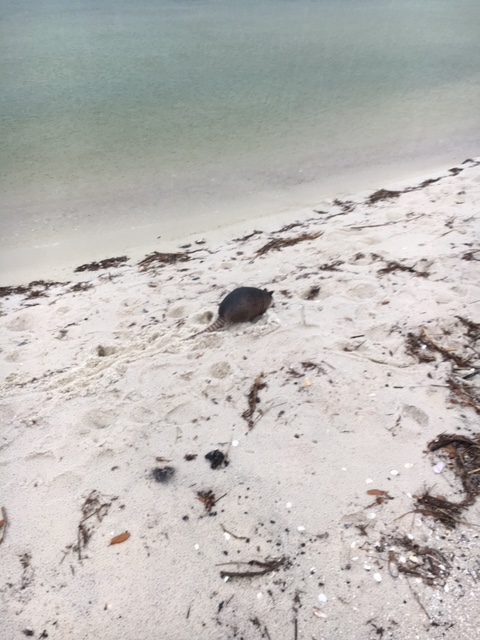
by Rick O'Connor | Aug 21, 2020
You are probably not going to see them… but they are there.
Mammals are fur covered warm blooded creatures. Beaches are hot, dry, sandy places. Just as in the deserts, it would make sense for island mammals to be nocturnal. We know of their existence by their tracks and their scat. Rabbit, raccoon, and armadillo tracks are quite common. Deer, coyote, and beach mice less so. All that said, some are seen at dawn and dusk and it is not unheard of to see them in the middle of the day – especially during the cooler months.
One question that may come up is – “how did they get to an isolated island?” Some scientists have a lot of fun trying to solve that mystery. Some island mammals, like otters, are very good swimmers and would have no problem. Many barrier islands begin as sand spits connected to the mainland – the mammals ventured out into new territory – set up camp – and either over time, or over night in a hurricane – the spit breaks off and the mammals are there. And let’s not forget we built bridges – they know how to use them. Coyotes have been seen walking across the Bob Sikes Bridge from Gulf Breeze.
Another question that comes up – “where are they in the middle of the day?” Most dig, or find, burrows and dens. Just a few inches below the surface it is very cool. Some will find thick hammocks in the maritime forest and “hunker down” for the day.

The sneaky raccoon is an intelligent creature and has learned to live with humans.
Photo: Molly O’Connor
Raccoons
The raccoon (Procyon lotor) is one of the more intelligent and fearless of the beach mammals. Their opportunistic behavior frequently brings them into contact with humans. They will scurry across your lawn at night looking for insects, cat food, garbage, whatever they can find to eat – and outdoor lights do not seem to bother them. There are even videos of them reaching into “dog doors” searching. On the island, their tracks are often found in the marsh areas – where they grab shellfish and are one of the few animals that wash their food before eating it. They usually like to settle into hollow trees during the day. But on the island, it is more likely burrows in the sand.
Their tracks might show the presence of a claw (always hard in soft sand – better chance in wet). The front foot is smaller than the back and they walk with an alternating pattern – usually the front and back foot are close to each other – unless they are running. The front foot is about 2.5”x2.5” – a little round, and the index from the pad to the tip is thinner. The hind foot is about 2.5” wide but closer to 4” long.
The scat is cigar shaped and about 3” long.
Read more:
https://myfwc.com/media/1666/livingwithraccoons.pdf.

The bizarre looking armadillo enjoys a walk on the beach.
Photo: Rick O’Connor
Armadillo
Here is an interesting creature. It doesn’t even look like a mammal – not sure what it looks like. But mammals they are. If you find one that has been hit by a car you can see, amongst the armored plating, hairs spaced across the body – they are mammals. It is one that is sometimes seen roaming in the middle of the day. They plunge through the leaf litter and bushes of the maritime forest, making a lot of noise, while searching for insects and grubs and crushing them with their peg-like teeth. They are not from around here – rather from central America – and worked their way into the American southwest and southeast. They probably reached the island via the bridges. They are prolific produces – usually having quadruplets of the same sex. You once found them occasionally in the national seashore – but since Hurricane Ivan, you can find them almost anywhere. One bothersome fact of this animal – they are known to carry leprosy – which can be contacted by eating the animal, or handling it.
Their tracks are one of the most common on the beach. The front foot is about 1.8” long and 1.4” wide. You will see only four toes and claw marks may be seen. The two middle toes are longer. The hind foot has a similar pattern, but you will see five toes and they are about 2.2” long. Most tracks include the tail drag between the foot marks. These are quite common all over the island.
The scat is round-ish and not very long – about 2”.
Read more:
https://edis.ifas.ufl.edu/pdffiles/UW/UW45600.pdf
https://myfwc.com/wildlifehabitats/profiles/mammals/land/armadillo/
https://www.floridamuseum.ufl.edu/science/five-facts-nine-banded-armadillo/.
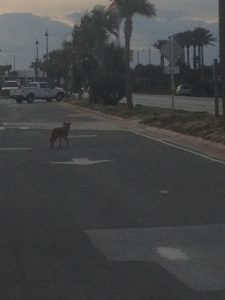
A coyote moving on Pensacola Beach near dawn.
Photo provided by Shelley Johnson.
Coyote
This is an animal that makes people nervous. They are one of the larger mammals on the beach, and they are carnivores. Attacks on pets and children are a concern for many. However, this is rarely the case. Studies show that they are actually very nervous around people and tend to stay at a distance. However, if fed cat food or available garbage, they will lose that fear and problems can occur. Like most island mammals, they are nocturnal, and diet studies have found the bulk of their meals are rodents – which is doing us a favor. But, like raccoons, they are intelligent and opportunistic. If they find an easy meal, like shorebird and turtle eggs – or the chicks and hatchlings – they will take them. It was once thought they were creatures of the American west and migrated into the eastern United States. Some scientists have found coyote remains in the eastern US that predate the ice age – so maybe they are just returning home. There are also reports of humans bringing them here for “fox hunts” – not realizing these were not fox. Either way, they are in all 67 counties of Florida, and on Pensacola Beach. They look similar to dogs – but will be thinner and their tails hang down between their legs when they run. One way to know if they are around is to listen when a siren is going – they tend to howl at these.
Their tracks are very similar to dogs and more people are bringing dogs onto the beach and into natural areas – hard to tell them apart. The pad at the rear of both the front and back paws of the coyote has three lobes, dogs have two on the front foot. In general, dog tracks are more round, coyotes typically are long and not as wide. Characteristic of dog family – the claw marks can be seen. Keep in mind that tracks are distorted in soft sand – best to look in wet sand.
The scat is also characteristic of wild canines – long and thin (like a hot dog) and tapered at each end (like a tamale). Coyote scat is usually 3-8” long and may have the characteristic claw scratching marks some dogs do.
Read more:
https://edis.ifas.ufl.edu/pdffiles/UW/UW44300.pdf.
https://myfwc.com/conservation/you-conserve/wildlife/coyotes/.
https://myfwc.com/wildlifehabitats/profiles/mammals/land/coyote/
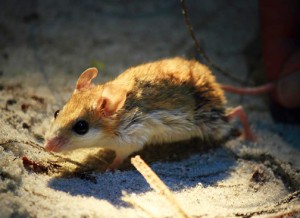
The Choctawhatchee Beach Mouse is one of four Florida Panhandle Species classified as endangered or threatened. Beach mice provide important ecological roles promoting the health of our coastal dunes and beaches. Photo provided by Jeff Tabbert
Beach Mouse
Beach mice are like the Loch Ness monster – everyone talks about them, but no one has seen one. Many locals have lived on this beach all of their lives and have never seen one – but they are there – and they are protected. The deal with protection is that these are isolated populations on each island. With no chance to mix genes, they have become “unique” and found no where else. There are four species in the state listed as endangered – including the nearby Perdido Key Beach Mouse and the Choctawhatchee Beach Mouse. It is believed the subspecies found on Pensacola Beach is the Santa Rosa Beach Mouse and is not listed as endangered – but is a species of concern (see list in link below). These little guys dig multiple burrows throughout the dune field but prefer those that are more open and have plenty of sea oats. They emerge at night feeding on a variety of seeds, fruits, and even insects – but sea oats are their favorite. It has been suggested they play an important role of dispersing these seeds. The introduction of new predators, and human development, have put these guys at high risk of extinction.
As you can imagine, the tracks are tiny. They are round in shape and show claw marks.
Read more:
https://edis.ifas.ufl.edu/pdffiles/UW/UW17300.pdf.
https://myfwc.com/media/1945/threatend-endangered-species.pdf.

by Carrie Stevenson | May 29, 2020

Baby terns on Pensacola Beach are camouflaged in plain sight on the sand. This coloration protects them from predators but can also make them vulnerable to people walking through nesting areas. Photo credit: UF IFAS Extension
The controversial incident recently in New York between a birdwatcher and a dog owner got me thinking about outdoor ethics. Most of us are familiar with the “leave no trace” principles of “taking only photographs and leaving only footprints.” This concept is vital to keeping our natural places beautiful, clean, and safe. However, there are several other matters of ethics and courtesy one should consider when spending time outdoors.
- On our Gulf beaches in the summer, sea turtles and shorebirds are nesting. The presence of this type of wildlife is an integral part of why people want to visit our shores—to see animals they can’t see at home, and to know there’s a place in the world where this natural beauty exists. Bird and turtle eggs are fragile, and the newly hatched young are extremely vulnerable. Signage is up all over, so please observe speed limits, avoid marked nesting areas, and don’t feed or chase birds. Flying away from a perceived predator expends unnecessary energy that birds need to care for young, find food, and avoid other threats.

When on a multi-use trail, it is important to use common courtesy to prevent accidents. Photo credit: Carrie Stevenson, UF IFAS Extension
- On a trail, the rules of thumb are these: hikers yield to equestrians, cyclists yield to all other users, and anyone on a trail should announce themselves when passing another person from behind.
- Obey leash laws, and keep your leash short when approaching someone else to prevent unwanted encounters between pets, wildlife, or other people. Keep in mind that some dogs frighten easily and respond aggressively regardless of how well-trained your dog is. In addition, young children or adults with physical limitations can be knocked down by an overly friendly pet.
- Keep plenty of space between your group and others when visiting parks and beaches. This not only abides by current health recommendations, but also allows for privacy, quiet, and avoidance of physically disturbing others with a stray ball or Frisbee.
Summer is beautiful in northwest Florida, and we welcome visitors from all over the world. Common courtesy will help make everyone’s experience enjoyable.
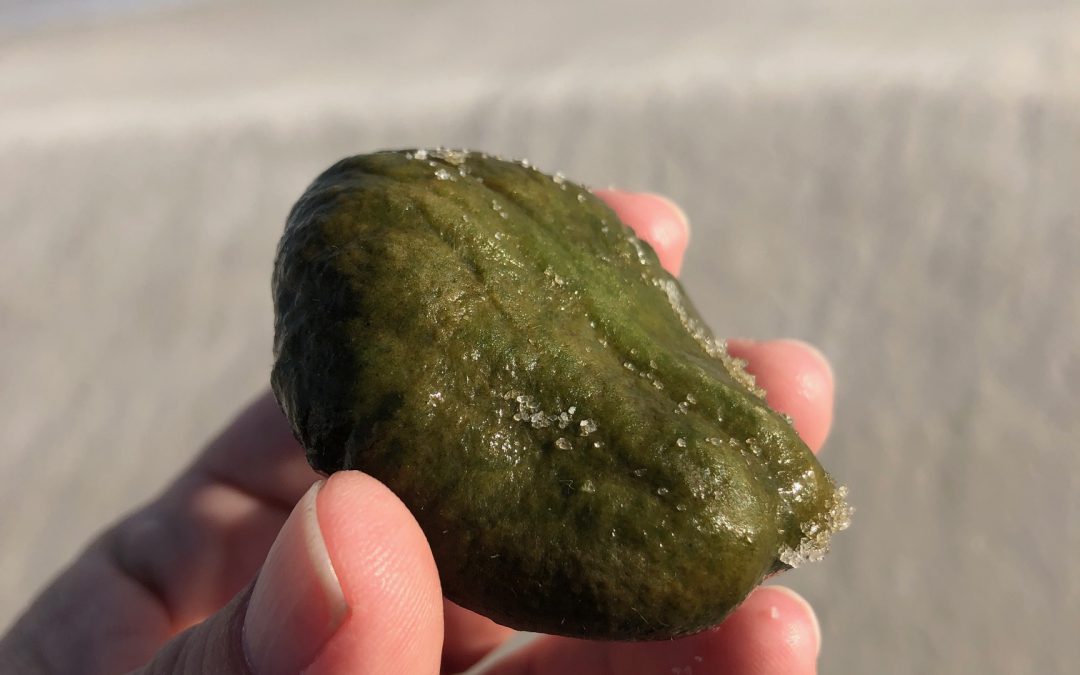
by Carrie Stevenson | May 22, 2020

Sea pork comes in a wide variety of shapes and sizes. Photo credit: Carrie Stevenson, UF IFAS Extension
Recently I was walking the beach, enjoying a sunset and looking around at the shells and other oddities in the wrack line where waves deposit their floating treasures. Something bright green and oblong caught my eye. It was emerald in color, smooth yet fuzzy at the same time, and firm to the touch. At first, I thought it was a sea bean–a collective term for the many species of seeds and fruits that float to our shores from tropical locations in the Caribbean or Central/South America. The bright green definitely seemed like something botanical in nature. However, the vast majority of sea beans have a woody, protective shell similar to our more familiar pecans or acorns.
I remembered a family member asking about finding a mystery chunk of pink mass she found on the beach a few years ago. It resembled a pork chop more than anything else.

A different variety of sea pork that really lives up to its name. Photo credit: Stephanie Stevenson, Duval County Master Gardener
Looking closer and consulting a couple of resources, I realized we had both (most likely!) happened upon one of the oddest and often-questioned finds on our beaches: sea pork. Ranging in color from beige and pale pink to red or green, sea pork is a tunicate (or sea squirt), a member of the Phylum Chordata, home to all the vertebrate and semi-vertebrate animals. While they look and feel more like a cross between invertebrate slugs or sponges, the tunicates are more advanced organisms, possessing a primitive backbone in their larval “tadpole” form. Despite their blob-like appearance, they are more closely related to vertebrate animals than they are to corals or sponges.

The unusual life cycle of the tunicate. Photo credit: University of Washington, used with permission with Florida Master Naturalist program
During their short (just hours-long) larval stage, the tunicate larvae uses its nerve cord (supported by a notochord similar to a vertebrate spine) to communicate with a cerebral vesicle, which works like a brain. Similar to fish, this primitive brain uses an otolith to orient itself in the water, and an eyespot to detect light. These brain-like tools are utilized to locate an appropriate location to settle permanently. Using a sticky substance, the tunicate will attach its head directly to a hard surface (rocks, boats, docks, etc.) and go through a metamorphosis of sorts. The tunicate reabsorbs its tail and starts forming the shape and structure it needs for adulthood.
As an adult, the organism has a barrel shape covered by a tough tunic-like skin (hence “tunicate”). Adult bodies have two siphons, one to bring water in, another to shoot it out (giving them their other nickname, the sea squirt). The water passes through an atrium with organs that allow it to filter feed, trapping plankton and oxygen. The tunicates will spend most of their lives attached to a surface, pumping water in and out as filter feeders. They may be solitary or live in colonies, and vary widely in color and shape, lending variety to those chunks of sea pork found washing up.
I am still awaiting positive identification from an expert on my green find to confirm that it is, indeed, a tunicate and not an unfamiliar plant. Consulting with Extension colleagues, for now we are pretty confidently going with green sea pork. If you have seen one of these before or something resembling sea pork, let us know! It is fascinating to see the variety and unusual shapes and colors.
.























